人教版(2019)选择性必修 第二册Unit 5 First Aid Reading and writing课件(共23张)
文档属性
| 名称 | 人教版(2019)选择性必修 第二册Unit 5 First Aid Reading and writing课件(共23张) | 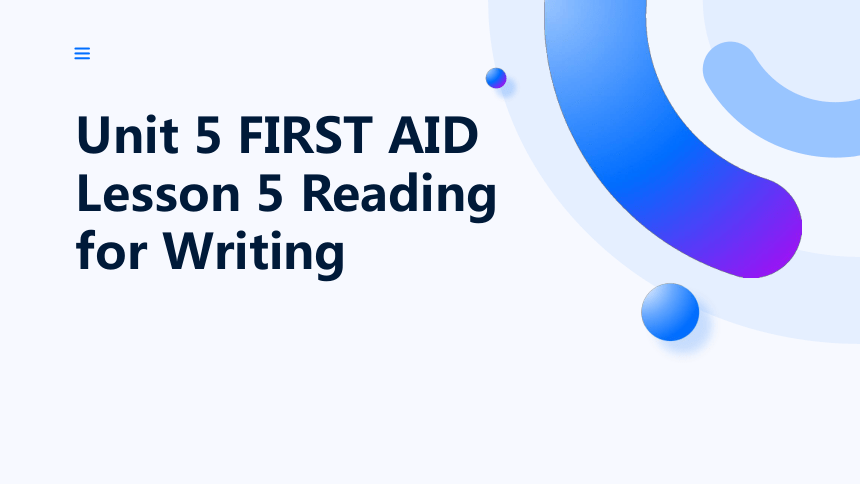 | |
| 格式 | pptx | ||
| 文件大小 | 2.1MB | ||
| 资源类型 | 教案 | ||
| 版本资源 | 人教版(2019) | ||
| 科目 | 英语 | ||
| 更新时间 | 2025-03-02 14:48:20 | ||
图片预览

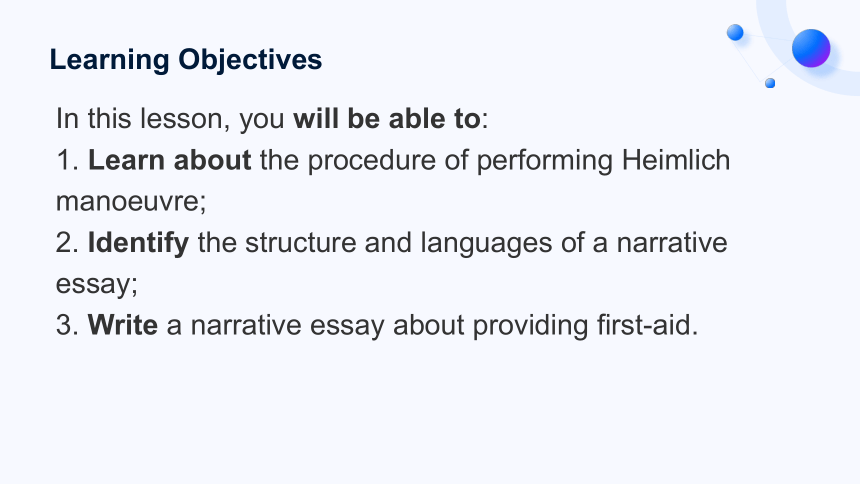

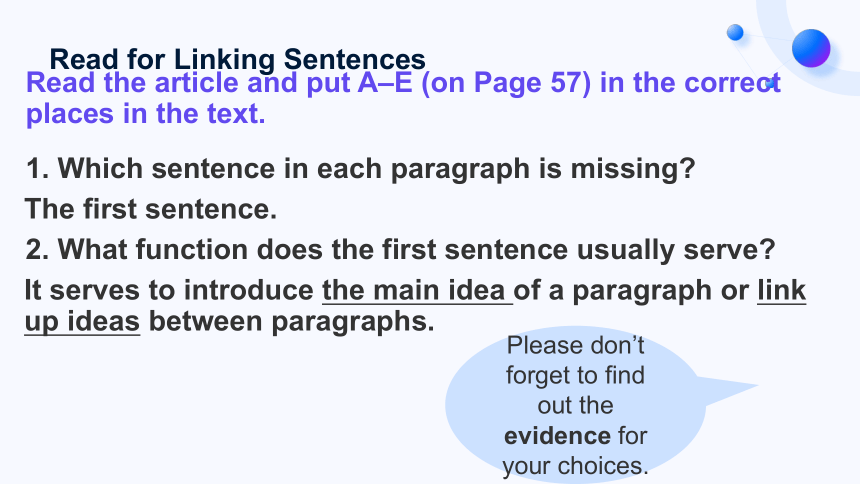
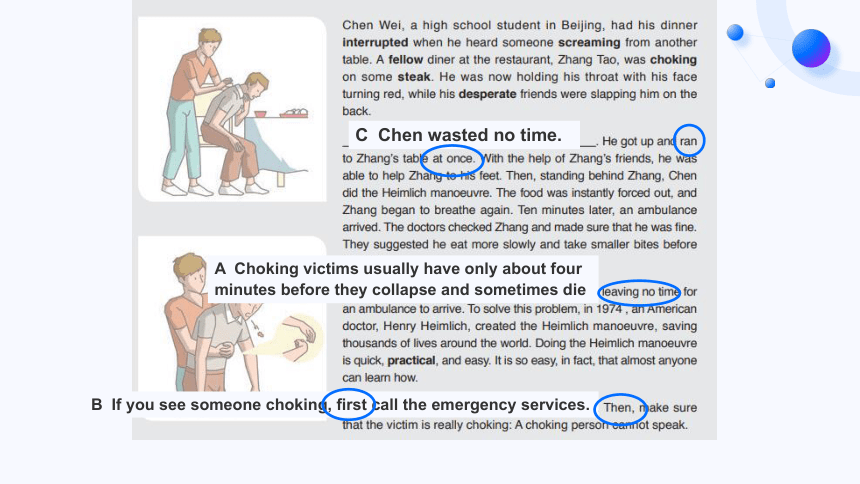
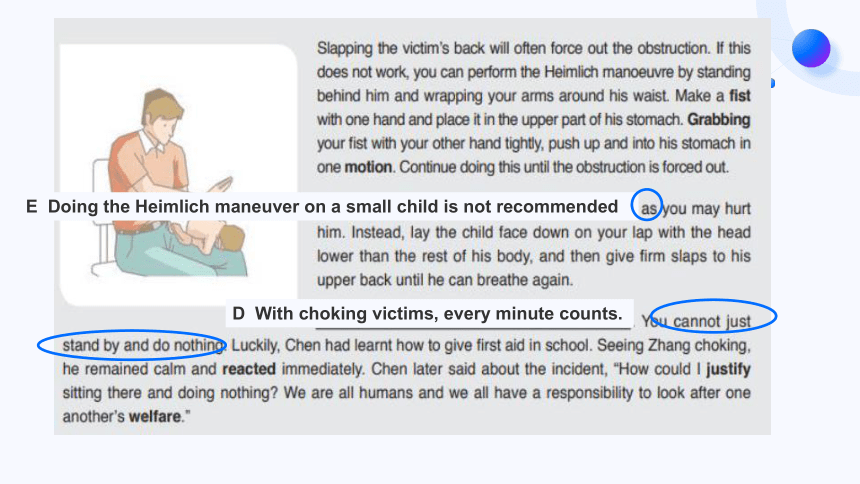
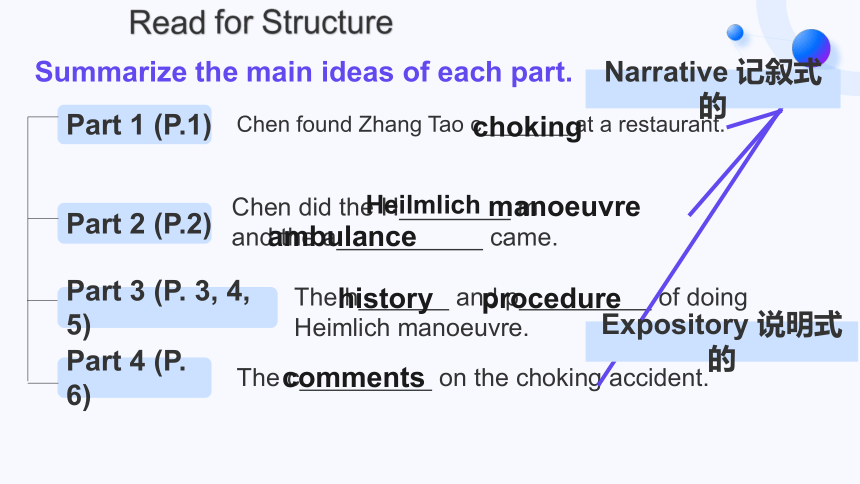
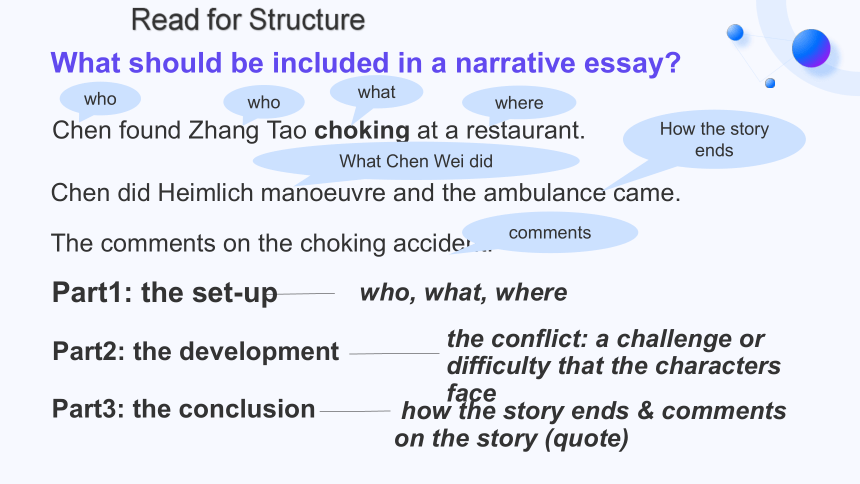

文档简介
(共23张PPT)
Unit 5 FIRST AID
Lesson 5 Reading for Writing
Learning Objectives
In this lesson, you will be able to:
1. Learn about the procedure of performing Heimlich manoeuvre;
2. Identify the structure and languages of a narrative essay;
3. Write a narrative essay about providing first-aid.
1. What do you think the boy on the right is suffering from
He is suffering from choking.
2. Which picture do you think shows the right way to help
The second one: performing the Heimlich manoeuvre.
Lead-in
Read the article and put A–E (on Page 57) in the correct places in the text.
1. Which sentence in each paragraph is missing
The first sentence.
2. What function does the first sentence usually serve
It serves to introduce the main idea of a paragraph or link up ideas between paragraphs.
Please don’t forget to find out the evidence for your choices.
Read for Linking Sentences
C Chen wasted no time.
A Choking victims usually have only about four minutes before they collapse and sometimes die
B If you see someone choking, first call the emergency services.
E Doing the Heimlich maneuver on a small child is not recommended
D With choking victims, every minute counts.
Summarize the main ideas of each part.
Part 1 (P.1)
Part 2 (P.2)
Part 3 (P. 3, 4, 5)
Part 4 (P. 6)
Chen found Zhang Tao c at a restaurant.
The h and p of doing Heimlich manoeuvre.
Chen did the H m and the a came.
The c on the choking accident.
choking
Heilmlich
manoeuvre
ambulance
history
procedure
comments
Narrative 记叙式的
Expository 说明式的
Read for Structure
What should be included in a narrative essay
Chen found Zhang Tao choking at a restaurant.
Chen did Heimlich manoeuvre and the ambulance came.
The comments on the choking accident.
who
who
where
what
How the story ends
comments
Part1: the set-up
Part2: the development
who, what, where
the conflict: a challenge or difficulty that the characters face
Part3: the conclusion
how the story ends & comments on the story (quote)
What Chen Wei did
Read for Structure
Chen Wei, a high school student in Beijing, had his dinner interrupted when he heard someone screaming from another table. A fellow diner at the restaurant, Zhang Tao, was choking on some steak. He was now holding his throat with his face turning red, while his desperate friends were slapping him on the back.
Read the 1st paragraph and find out the description of the emergency.
action
+
facial expressions/ emotions
图片来源于网络
Read for Language
Chen wasted no time. He got up and ran to Zhang’s table at once. With the help of Zhang’s friends, he was able to help Zhang to his feet. Then, standing behind Zhang, Chen did the Heimlich manoeuvre.
Read the 2nd paragraph and find out the verbs used to describe Chen’s reaction.
help sb to his/her feet: help sb stand up
What did the underlined verbs show about Chen’s reaction
His help was quick, timely (及时的) and professional.
Read for Language
If you see someone choking, first call the emergency services. Then, make sure that the victim is really choking: A choking person cannot speak. Slapping the victim’s back will often force out the obstruction. If this does not work, you can perform the Heimlich manoeuvre by standing behind him and wrapping your arms around his waist. Make a fist with one hand and place it in the upper part of his stomach. Grabbing your fist with your other hand tightly, push up and into his stomach in one motion. Continue doing this until the obstruction is forced out.
Read the 4th and find out the verbs used to describe how to deal with choking.
Before Heimlich manoeuvre
Call the emergency
Make sure that…
Slap the victim’s back
Performing Heimlich manoeuvre
Stand behind him
Wrap your arms…
Make a fist and place it…
Grab your fist
Push up and into…
Read for Language
Read the 5th paragraph and find out how to perform Heimlich manoeuvre on a small child.
Doing the Heimlich maneuver on a small child is not recommended, as you may hurt him. Instead, lay the child face down on your lap with the head lower than the rest of his body, and then give firm slaps to his upper back until he can breathe again.
precise (精确的) action
+
precise position
Read for Language
Situations Verbs used Others
Emergency
Reaction
How to perform Heimlich manoeuvre
How to perform Heimlich manoeuvre on a small child
Hear sb screaming
Choke on some steak
Hold his throat
His face turning red (facial expressions)
Desperate (emotions)
Got up and ran
Help Zhang to his feet
Stand before
Stand behind
Wrap your arms around his waist
Make a fist and grab your fist
Push up and into his stomach
Continue doing this
Before Heimlich manoeuvre:
Call the emergency
Make sure that…
Slap the victim’s back
Lay the child
Give firm slaps
Position:
Face down on your lap
With head lower than…
To his upper back
Use precise verbs and add other details
Summary1
Read the 1st paragraph and find out how the author linked the sequential (按顺序的) actions or events.
Chen Wei, a high school student in Beijing, had his dinner interrupted when he heard someone screaming from another table. A fellow diner at the restaurant, Zhang Tao, was choking on some steak. He was now holding his throat with his face turning red, while his desperate friends were slapping him on the back.
Read for Language
Read the 2nd paragraph and find out how the author linked the sequential (按顺序的) verbs.
Chen wasted no time. He got up and ran to Zhang’s table at once. With the help of Zhang’s friends, he was able to help Zhang to his feet. Then, standing behind Zhang, Chen did the Heimlich manoeuvre. The food was instantly forced out, and Zhang began to breathe again. Ten minutes later, an ambulance arrived. The doctors checked Zhang and made sure that he was fine. They suggested he eat more slowly and take smaller bites before they left.
Read for Language
Types Examples from the text More examples
Adverbial
Adverbial Clauses
V. ing-form
Now
At once
Then,…
Instantly
Again
Ten minutes later
Immediately,
Before/after that
Soon,…
…
when + instant action
while + continuous action
before + sentence
after + sentence
until + sentence
as soon as + sentence
Use proper ways to link sequential actions
hear someone screaming
with his face turning red
standing behind, … did…
Summary2
Read the last paragraph and think about the meaning of the quote.
Read for Language
How could I justify sitting there and doing nothing
We are all humans and we all have a responsibility to look after one another’s welfare.
It echoes (回应) the previous statement “you cannot just stand by and do nothing” and shows Chen’s kindness and helpfulness.
the general health, happiness and safety
It serves as a call (呼吁) for learning first-aid as a way to help others and ourselves as well.
A proper quote can show the character’s moral (品德), the theme or serves as a strong call for certain action.
The quote in the end depends on your theme.
life-saving
“First-aid is for everyone everywhere.”
“Safety brings first-aid to the uninjured.” – F.S.Huges
“Accidents do happen; make first-aid your best mate.”
first-aid
“You don’t have to be a doctor to save lives.”
“Next to creating a life the finest thing a man can do is to save one.” -- Abraham Lincoln
“We all have the power to save a life.”
You can choose either a part of the character’s saying or a great man’s as long as your quote helps strengthen your theme.
How to choose a good quote
Extension
Use what you have learnt to write a narrative essay that shares a story about providing first aid.
Write an outline of the three parts in your story. Then think of a good quote to sum things up.
Parts Elements Key words
1 Set-up Who Where What happened
2 Development Any conflict(s)
3 Conclusion How does the story end Any comment(s)/ quote(s)
What person/perspective should be used
What verb tense should be used
The first/third person.
Past tense.
Pre-Writing
Use this checklist to help you revise the draft.
Does your work have three parts
Does the first part tell the readers about who, what, and where
Does the second part show a conflict
Does the third part give the conclusion
Is there a good quote to sum things up
Are the verbs used in your work clear and precise
Are the sequential actions linked in a coherent way
Are the V.ing form used in your work
Pre-Writing
Key Competence We are able to…
Language ability Read a hospital leaflet and a narrative story on first-aid
Understand and make an emergency call in English
Write a narrative essay on first-aid with topic-related vocabulary in a logical and coherent way
Understand and use the V.ing form in different situations
Learning ability Identify the text type by style of writing and language features
Pay close attention to the imperative sentences and adverbials in guiding first-aid
Analyze the writing style of narrative essays
Summary of the Unit
Key Competence We are able to…
Cultural Awareness Learn about the emergency numbers in several countries
Learn about the first-aid treatments and their procedures at home and abroad
Thinking Ability Think about the importance of first-aid
Organize the first-aid information, including first-aid treatments on common emergencies and usage of first-aid kit in case they are needed
Summary of the Unit
After-Class Homework
Write a narrative essay about providing first-aid in an emergency. It can be your personal experience or the stories you have read or heard about. Refer to your outline, what we have learnt and the check-list to help with your writing.
Unit 5 FIRST AID
Lesson 5 Reading for Writing
Learning Objectives
In this lesson, you will be able to:
1. Learn about the procedure of performing Heimlich manoeuvre;
2. Identify the structure and languages of a narrative essay;
3. Write a narrative essay about providing first-aid.
1. What do you think the boy on the right is suffering from
He is suffering from choking.
2. Which picture do you think shows the right way to help
The second one: performing the Heimlich manoeuvre.
Lead-in
Read the article and put A–E (on Page 57) in the correct places in the text.
1. Which sentence in each paragraph is missing
The first sentence.
2. What function does the first sentence usually serve
It serves to introduce the main idea of a paragraph or link up ideas between paragraphs.
Please don’t forget to find out the evidence for your choices.
Read for Linking Sentences
C Chen wasted no time.
A Choking victims usually have only about four minutes before they collapse and sometimes die
B If you see someone choking, first call the emergency services.
E Doing the Heimlich maneuver on a small child is not recommended
D With choking victims, every minute counts.
Summarize the main ideas of each part.
Part 1 (P.1)
Part 2 (P.2)
Part 3 (P. 3, 4, 5)
Part 4 (P. 6)
Chen found Zhang Tao c at a restaurant.
The h and p of doing Heimlich manoeuvre.
Chen did the H m and the a came.
The c on the choking accident.
choking
Heilmlich
manoeuvre
ambulance
history
procedure
comments
Narrative 记叙式的
Expository 说明式的
Read for Structure
What should be included in a narrative essay
Chen found Zhang Tao choking at a restaurant.
Chen did Heimlich manoeuvre and the ambulance came.
The comments on the choking accident.
who
who
where
what
How the story ends
comments
Part1: the set-up
Part2: the development
who, what, where
the conflict: a challenge or difficulty that the characters face
Part3: the conclusion
how the story ends & comments on the story (quote)
What Chen Wei did
Read for Structure
Chen Wei, a high school student in Beijing, had his dinner interrupted when he heard someone screaming from another table. A fellow diner at the restaurant, Zhang Tao, was choking on some steak. He was now holding his throat with his face turning red, while his desperate friends were slapping him on the back.
Read the 1st paragraph and find out the description of the emergency.
action
+
facial expressions/ emotions
图片来源于网络
Read for Language
Chen wasted no time. He got up and ran to Zhang’s table at once. With the help of Zhang’s friends, he was able to help Zhang to his feet. Then, standing behind Zhang, Chen did the Heimlich manoeuvre.
Read the 2nd paragraph and find out the verbs used to describe Chen’s reaction.
help sb to his/her feet: help sb stand up
What did the underlined verbs show about Chen’s reaction
His help was quick, timely (及时的) and professional.
Read for Language
If you see someone choking, first call the emergency services. Then, make sure that the victim is really choking: A choking person cannot speak. Slapping the victim’s back will often force out the obstruction. If this does not work, you can perform the Heimlich manoeuvre by standing behind him and wrapping your arms around his waist. Make a fist with one hand and place it in the upper part of his stomach. Grabbing your fist with your other hand tightly, push up and into his stomach in one motion. Continue doing this until the obstruction is forced out.
Read the 4th and find out the verbs used to describe how to deal with choking.
Before Heimlich manoeuvre
Call the emergency
Make sure that…
Slap the victim’s back
Performing Heimlich manoeuvre
Stand behind him
Wrap your arms…
Make a fist and place it…
Grab your fist
Push up and into…
Read for Language
Read the 5th paragraph and find out how to perform Heimlich manoeuvre on a small child.
Doing the Heimlich maneuver on a small child is not recommended, as you may hurt him. Instead, lay the child face down on your lap with the head lower than the rest of his body, and then give firm slaps to his upper back until he can breathe again.
precise (精确的) action
+
precise position
Read for Language
Situations Verbs used Others
Emergency
Reaction
How to perform Heimlich manoeuvre
How to perform Heimlich manoeuvre on a small child
Hear sb screaming
Choke on some steak
Hold his throat
His face turning red (facial expressions)
Desperate (emotions)
Got up and ran
Help Zhang to his feet
Stand before
Stand behind
Wrap your arms around his waist
Make a fist and grab your fist
Push up and into his stomach
Continue doing this
Before Heimlich manoeuvre:
Call the emergency
Make sure that…
Slap the victim’s back
Lay the child
Give firm slaps
Position:
Face down on your lap
With head lower than…
To his upper back
Use precise verbs and add other details
Summary1
Read the 1st paragraph and find out how the author linked the sequential (按顺序的) actions or events.
Chen Wei, a high school student in Beijing, had his dinner interrupted when he heard someone screaming from another table. A fellow diner at the restaurant, Zhang Tao, was choking on some steak. He was now holding his throat with his face turning red, while his desperate friends were slapping him on the back.
Read for Language
Read the 2nd paragraph and find out how the author linked the sequential (按顺序的) verbs.
Chen wasted no time. He got up and ran to Zhang’s table at once. With the help of Zhang’s friends, he was able to help Zhang to his feet. Then, standing behind Zhang, Chen did the Heimlich manoeuvre. The food was instantly forced out, and Zhang began to breathe again. Ten minutes later, an ambulance arrived. The doctors checked Zhang and made sure that he was fine. They suggested he eat more slowly and take smaller bites before they left.
Read for Language
Types Examples from the text More examples
Adverbial
Adverbial Clauses
V. ing-form
Now
At once
Then,…
Instantly
Again
Ten minutes later
Immediately,
Before/after that
Soon,…
…
when + instant action
while + continuous action
before + sentence
after + sentence
until + sentence
as soon as + sentence
Use proper ways to link sequential actions
hear someone screaming
with his face turning red
standing behind, … did…
Summary2
Read the last paragraph and think about the meaning of the quote.
Read for Language
How could I justify sitting there and doing nothing
We are all humans and we all have a responsibility to look after one another’s welfare.
It echoes (回应) the previous statement “you cannot just stand by and do nothing” and shows Chen’s kindness and helpfulness.
the general health, happiness and safety
It serves as a call (呼吁) for learning first-aid as a way to help others and ourselves as well.
A proper quote can show the character’s moral (品德), the theme or serves as a strong call for certain action.
The quote in the end depends on your theme.
life-saving
“First-aid is for everyone everywhere.”
“Safety brings first-aid to the uninjured.” – F.S.Huges
“Accidents do happen; make first-aid your best mate.”
first-aid
“You don’t have to be a doctor to save lives.”
“Next to creating a life the finest thing a man can do is to save one.” -- Abraham Lincoln
“We all have the power to save a life.”
You can choose either a part of the character’s saying or a great man’s as long as your quote helps strengthen your theme.
How to choose a good quote
Extension
Use what you have learnt to write a narrative essay that shares a story about providing first aid.
Write an outline of the three parts in your story. Then think of a good quote to sum things up.
Parts Elements Key words
1 Set-up Who Where What happened
2 Development Any conflict(s)
3 Conclusion How does the story end Any comment(s)/ quote(s)
What person/perspective should be used
What verb tense should be used
The first/third person.
Past tense.
Pre-Writing
Use this checklist to help you revise the draft.
Does your work have three parts
Does the first part tell the readers about who, what, and where
Does the second part show a conflict
Does the third part give the conclusion
Is there a good quote to sum things up
Are the verbs used in your work clear and precise
Are the sequential actions linked in a coherent way
Are the V.ing form used in your work
Pre-Writing
Key Competence We are able to…
Language ability Read a hospital leaflet and a narrative story on first-aid
Understand and make an emergency call in English
Write a narrative essay on first-aid with topic-related vocabulary in a logical and coherent way
Understand and use the V.ing form in different situations
Learning ability Identify the text type by style of writing and language features
Pay close attention to the imperative sentences and adverbials in guiding first-aid
Analyze the writing style of narrative essays
Summary of the Unit
Key Competence We are able to…
Cultural Awareness Learn about the emergency numbers in several countries
Learn about the first-aid treatments and their procedures at home and abroad
Thinking Ability Think about the importance of first-aid
Organize the first-aid information, including first-aid treatments on common emergencies and usage of first-aid kit in case they are needed
Summary of the Unit
After-Class Homework
Write a narrative essay about providing first-aid in an emergency. It can be your personal experience or the stories you have read or heard about. Refer to your outline, what we have learnt and the check-list to help with your writing.
